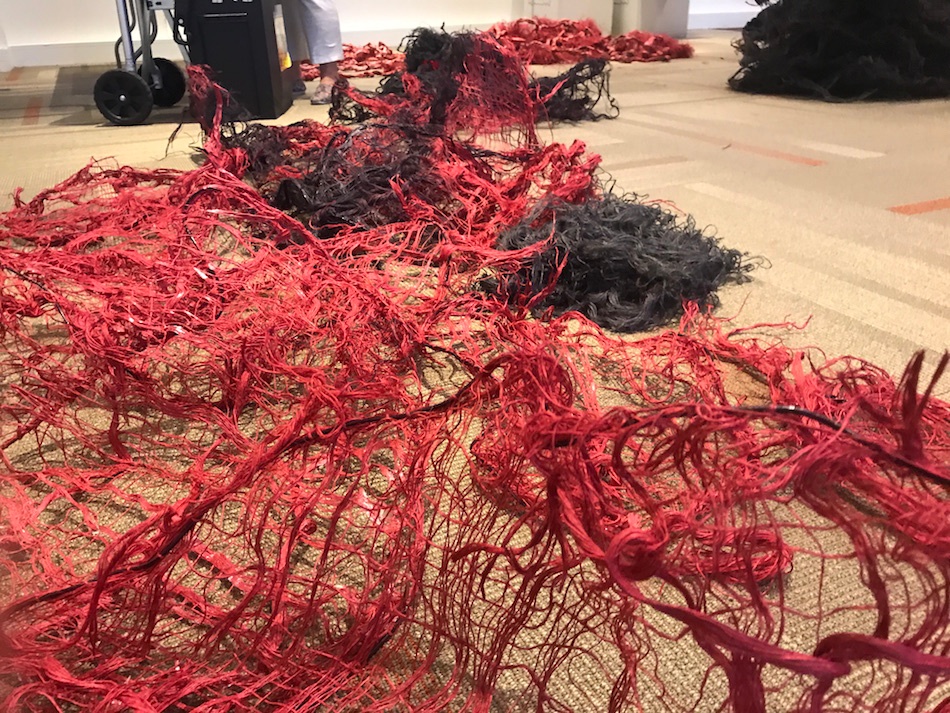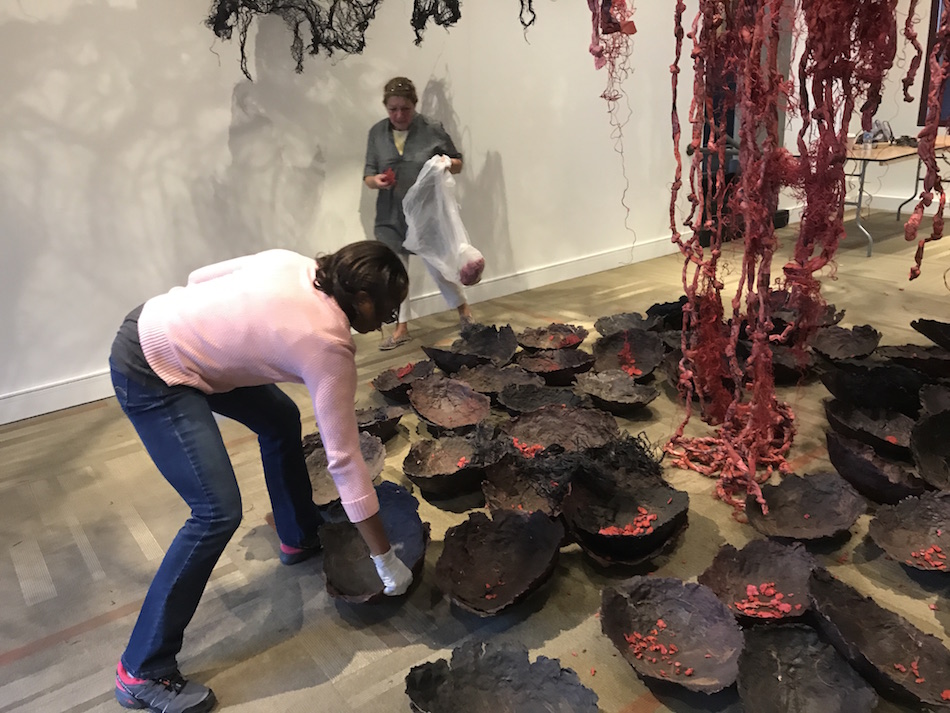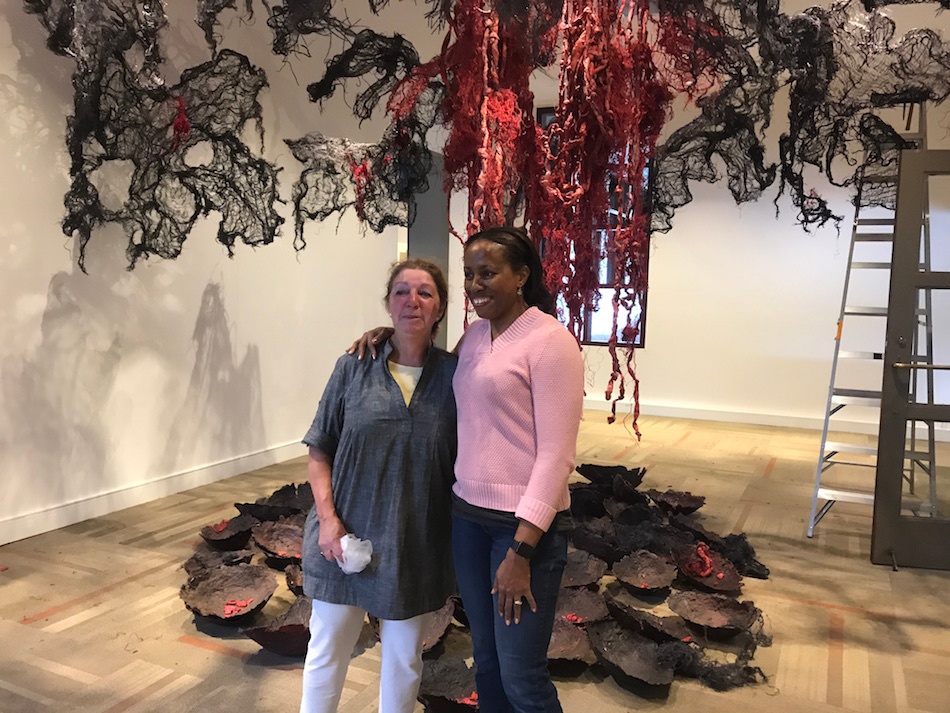
Mattatuck Museum | Arts & Culture | Nnenna Okore | Ùtútù | Visual Arts | Waterbury
 Nnenna Okore. Mattatuck Museum Photos.
Nnenna Okore. Mattatuck Museum Photos.
Nnenna Okore woke at the crack of dawn to bring “morning” to the Mattatuck Museum. A Chicago-based fiber artist and professor, Okore flew out for Bradley International Airport at 5 a.m. the day she was scheduled to hang her new work “Ùtútù” in the Mattatuck’s “Lab” exhibition space. A room-sized sculptural installation, “Ùtútù” takes its title from the Igbo word for the time of day Okore began her labors—an homage to her childhood in Nsukka, Nigeria.
From 10 a.m. until she absolutely had to leave for that evening’s return flight, Okore worked to arrange “Ùtútù’s” jute, wax, wire, and paper parts.
“I have young kids, so I normally travel out on the same day to be home with my kids,” she said in an interview following the installation. “I’ve done it so often that I’ve learned how to manage my time. It’s quite intense—it adds a lot of flavor to the creative process.”
Approximately twelve feet tall, “Ùtútù” consists of a trunk of knotted cords made from repurposed newspaper, a spreading canopy of jute fuzz teased over wire armatures, and about thirty black papier-mâché half-spheres clustered along the floor, their convex sides turned ceiling-up. Bunches of cotton yarn add vivid, crimson flecks to “Ùtútù’s” mostly monochrome pink palette. The whole ensemble is suspended from above by clear, high-tensile monofilament cable. Imagined from a bird’s eye, it describes a lumpy circle about nine to ten feet in diameter.
Okore’s radical reconfiguration of commonplace stuff offers up a double image of an effeminate environment. Building on a common theme in the artist’s exhibition history, “Ùtútù” re-presents women as a force of nature by uplifting and valuing materials we struggle to see as having any agency of their own. The sculpture spoke to a number of visiting, Connecticut practitioners in the fiber arts—a historically underappreciated genre with a deep potential for social and political critique.
 From 10 a.m. until she absolutely had to leave for that evening’s return flight, Okore worked to arrange “Ùtútù’s” jute, wax, wire, and paper parts.
From 10 a.m. until she absolutely had to leave for that evening’s return flight, Okore worked to arrange “Ùtútù’s” jute, wax, wire, and paper parts.
Okore was first contacted by Mattatuck curator Cynthia Roznoy after a 2014 Washington, D.C.-area exhibit. Okore and Roznoy debated at length whether they should showcase one of Okore’s pieces or many, whether they should use one room at the Mattatuck or several.
“I preferred one room—it was more stimulating,” Okore said.
“Ùtútù” utilizes “The Lab,” an experimental gallery that was formerly the Mattatuck’s dining room. At “Ùtútù’s” opening reception in September, Roznoy detailed how director Bob Burns wanted visitors to enter the Waterbury museum’s lobby and be immediately confronted by big, demanding art. Roznoy listed off past exhibits: large-scale, framed photography; a seascape of light-emitting diode (LED) anemone, floating up from the floor.
She was particularly pleased by “Ùtútù.” Okore and Roznoy both maintained that “Ùtútù” is unique to the Mattatuck Museum because its components have never before been configured in quite this way. This explanation understates how “Ùtútù” helps the museum meet its goal of challenging guests straight out the door. It solves a programming problem specific to the site.
“This is what Bob had in mind,” grinned Roznoy.
Okore spoke at length about one of “Ùtútù’s” components: its distinctive “belly-forms.” They’re shallow, leathery-looking bowls with a cracked and crumpled outer rim. Okore waxed these forms and embedded hatches of brown jute twine in their semi-glossy surface, or sprinkled pulped red paper into their cavities. They suggest spent avocado hulls, or empty dragon’s eggs.
Okore has salvaged these belly-forms from previous installations, and for good reason: they’re cast from ceramic molds taken during her three pregnancies.
“I normally do casts of my belly to retain the memory,” she explained. Okore first used the belly-forms towards a 2009 exhibit in Denmark, supporting the United Nations Copenhagen Climate Change Conference. There, the belly-forms helped link women to nature as conduits for life.
“We were exploring the role of women in the natural world, how they could speak to conserving the environment,” she said. “Women have the power to protect the environment, because we are nurturers. I’m an environmental advocate!”
From dust to dust and dawn to dusk, Okore gives up a vision of Mother Earth as the ultimate upcycler.
“No matter how deadened nature becomes, it always offers a new start. When things die, they offer the potential for life.”
So is there any life left in “Ùtútù?” At first glance, the sculpture is frightening—grisly, even. If “Ùtútù” is an image of fecundity, of pregnancy, the baby’s elsewhere. The audience is left with dead or dying viscera, an afterbirth dripping down. Okore’s belly-forms “index,” or fossilize something vital that no longer exists: her mommy tummy.
As a concrete, constructed thing, then, “Ùtútù” enshrines and substantiates a weird, morbid, psychoanalytic lack—an absence of life. By initially denying viewers the picture of renewal and regeneration implied by her title, Okore disappears “Ùtútù.” Given that the default gallery-goer’s gaze is voyeuristically male, Okore herein gets in a feminist comment: an ostensibly female object, “Ùtútù” does not and will not reveal itself at our first, aggressive, seeking glance.
 Okore: “We were exploring the role of women in the natural world, how they could speak to conserving the environment.”
Okore: “We were exploring the role of women in the natural world, how they could speak to conserving the environment.”
To understand “Ùtútù” as an affirmative, nurturing image—if you find yourself at the exhibition—try literally looking at it from another angle. Crouching down low, sitting cross-legged on the floor, the black jute gossamer arches overhead like leafy branches. The yellow-orange glare of the track lighting helps to obscure some of the nastier pinks and reds, filtering them down to deep, oaky browns. Seen again, “Ùtútù” rises again—embracing the beholder as a thriving, lone acacia, lit by daybreak. “Ùtútù” might very well reward compromise and accommodation, a real change in the beholder’s privileged point of view.
Okore additionally went into detail about the mysterious process of feeling out new shapes and giving old materials a second wind. Dead on the outside, perhaps, “Ùtútù” pulses with the inner life of things, what Okore terms “the being of the form.”
“I’m trying to figure out what things want to do,” she said. “I’ve given myself permission to say: ‘I have this material, it’s flimsy, it does these things, how can I help it?’ It is a combination of letting go of control and working by instinct.”
Despite her extensive oeuvre and international renown as a sculptor, Okore expressed a welcome humility—a willingness to relinquish individualistic, artistic aims. She resists a domineering, authorial attitude that would make her the masculine master of “Ùtútù’s” feminine nature. She undoes a common, misogynistic trope in the arts and a commonplace of Western thought. Nature is not inert matter, to be used and abused.
“Sometimes it falls apart,” Okore added. “‘It fell apart! Maybe that’s what it wants to do. I should let it be.’ Rather than become challenged or frustrated, I take that as a cue to go in another direction.”
Speaking with members from the Connecticut chapter of Studio Art Quilt Associates (SAQA), this tendency to bend elegantly instead of push vainly emerged as a common trait among the fiber arts community. SAQA had come out in force the day before “Ùtútù’s” opening reception for a guided tour. Several members were in attendance the following afternoon.
Christina Blais gave insights into how she and her art quilter colleagues received a monumental, three-dimensional emplacement like “Ùtútù.”
“Some of our work is going a little more sculptural,” Blais said. “But it’s harder to display.”
She explained that although some art quilters go in for wearables, the vast majority of quilters stick to two dimensional textiles in order to maximize their chances with juries. With not a little consternation, they adjust their practice to thrive as best they can among local museums and gallery owners.
“They want things that roll up and can go into a box,” she said.
SAQA associates Rosalind Spann and Mary Lachman lamented how difficult it is for fiber artists to receive recognition as creative professionals.
“People don’t get fabric turned into art,” Spann began. “People often say ‘Oh—that’s a quilt!’” She shook her head accusatorially, lowering her voice to a sarcastic whisper. “Does that look like a quilt to you!?”
Lachman, a Bethany resident whose art quilt “Knight and Day” was on display at the Mattatuck’s concurrent“#IBelieveinWaterbury” show, helped clarify the diversity of techniques and materials that went into an average art quilt, distinguishing it from more mundane home goods. An art quilt, she said, includes “anything from wool to cloth to yarn to metal to plastic to paper. People stamp and paint and embellish and cut and chop and weave.”
Her own “Knight and Day” was made up of hand-dyed and commercial cotton fabrics, embroidered and quilted with vibrant orange thread. Draped above the threshold to a Mattatuck gallery—about the size of a typical genre or landscape painting—“Knight and Day” centers a profile silhouette of a prancing horse in a white ground that’s shot through with pink and blue clouds. A delicate patchwork of purple material heightened by iridescent blue, green, and yellow foliate patterns defines the animal’s body.
Lachman took cues from local, contemporary impressionist Dimitri Wright—also on display at the Matt.
“His use of color and texture makes it seem like every part of the picture is moving. I also like bright colors. He has an enthusiasm for life that I think I see in his work. I try to communicate joy!”
Like the ecologically-minded Okore at the Copenhagen Climate Conference, art quilters also stand on the front lines of critical civic and societal debates.
“Many fiber artists, art quilters, have a political streak,” Christina Blais continued. “There’s currently a show up called ‘Threads of Resistance’ taking a stand against Trumpism!”
Rosalind Spann leaned in and suggested that Blais speak about her own advocacy.
“Oh! I did a quilt—Rosa had got me into it—for the 50th anniversary of the Civil Rights Act!” Blais recounted the story of Rosa Parks. Parks recalled that during her famous refusal to move to the back on a Montgomery bus, she had “felt determination cover me like a quilt on a winter night.”
“I said: ‘I had to do that!’”
Blais exhibited the resulting art quilt first at the Hartford Public Library, and then at “Context” in St. Charles, Missouri. “Context” sought to interrogate the relationship between word, image, and public life in contemporary art, and did not call for fiber artists in particular.
She got a kick out of a comment from one critiquing juror. Unaware that Blais was an art quilter by practice, the juror innocently recommended she organize an installation with her piece spread out like a quilt on a bed. Blais was proud her work could stand on its own: art first, quilt later.
“I believe my text works are graphic art,” she beamed.
Whether they take on global warming as cosmopolitan world-citizens, or grow specific, hyperlocal networks for the production of socially-engaged art, fiber artists create some fiercely independent objects. They work in materials that are either rampantly and unsustainably consumed or somehow expected to comfort and coddle. In so doing, they challenge power hierarchies at the level of their media, in their status as makers, and—quite frequently—along lines of gender and sexuality. Blais summed it up best.
“Sometimes, fiber artists are viewed as ‘craftsmen,’ not artists. Well—we’re not making your grandma’s quilts, and they’re not going on your bed!”
Ùtútù will be on display at the Mattatuck Museum, 144 W. Main St., Waterbury through Sunday, Dec. 3. For admission information and visiting hours visit the museum's website.

